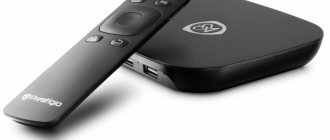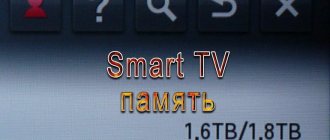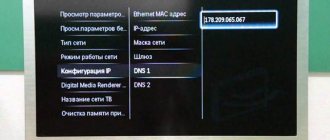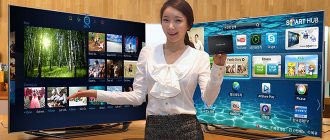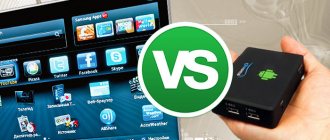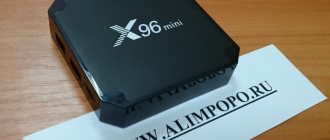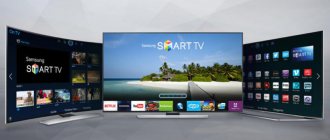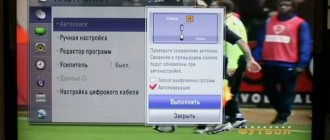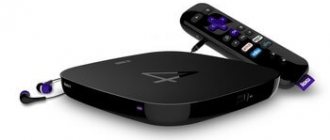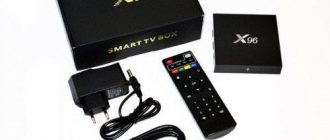Features of built-in memory
The lack of built-in memory of SMART TV receivers of any brand, including Samsung, is due to the fact that first the selected video file is loaded into the internal storage device and only then broadcast on the screen. As playback progresses, memory is freed up, but if the process of clearing it is slower than loading content, it may become full . In turn, this causes an error message to appear on the TV screen and the inability to continue viewing. It is interesting that even specialists from the Samsung Group, which is considered the leader in this market segment, have so far failed to solve the existing problem at a constructive level.
Thus, the browser of any Samsung Smart-TV television receiver (for example, models Ue46f6400ak, Ue43m5500, etc.) has limited capabilities, which is due to insufficient internal memory, without which downloading video content is impossible. Its main features:
- self-cleaning is carried out only if the content is loading slower than the video playback speed on the screen;
- The amount of memory cannot be increased by using an external storage device (hard drive, flash drive, etc.);
- Memory overflow is not associated with any specific application, website or Internet page and can occur at any time.
Important! The built-in memory can only become full when working with Internet resources. This effect does not occur when watching regular TV channels.
Why does the memory full error appear?
The internal memory of the TV is used in two cases:
- Storing system information for the proper operation of the device, as well as for installing various applications;
- Storing a cache – information that is temporarily stored in memory. These files appear when you launch installed applications or play audio and video files.
The memory overflow error can occur in different situations. These include:
- Attempts to install a new program;
- Playback of audio and video files;
- Attempts to open system browsers
Sometimes this error may appear while viewing a website through a TV. In this case, the content displayed on the screen will freeze and a loading icon (hourglass or spinning circle) will appear. After a while, the content will start playing again, but not for long - after a couple of minutes everything will freeze again. Very often, users begin to suspect that their Internet connection has a weak signal, but sometimes the problem lies in the same lack of memory.
The cache gets clogged especially often when browsing websites and playing files from the Internet. Internet distribution services are usually very busy, so connection and download speeds are uneven and can sometimes drop to zero. To ensure video and audio playback in good quality, the operating system pre-loads the necessary data into the internal memory of the TV, and then displays the picture and sound on the television screen. If the memory is full, the quality will decrease and the download will sag.
Also, when the internal memory is full of installed applications, it becomes insufficient, making it impossible to install new programs and run installed ones. In this case, you just need to delete some applications.
If the main problem is a cache full of information garbage, then it will have to be cleared using third-party programs or the OS.
Diagnostics and troubleshooting
EEPROM operates on the I2C . The SDA and SCL lines of this bus are pulled up by + resistors. The processor starts up and reads data from the EEPROM . The voltage on the SDA and SCL lines is approximately 3V. When the TV is started, signals exchanged between the processor and EEPROM on the SDA and SCL lines via the I2C can be seen using an oscilloscope.
If data exchange does not occur, it is worth checking:
- Flash memory
- Software stored in Flash memory (Firmware)
- CPU Clock (Quartz Resonator)
- CPU power
What problems may arise
- The plasma panel does not see the flash drive - the reasons for this problem may be the following: the device may not turn on due to a breakdown or due to incompatibility of systems. In this case, you need to determine in which file system the device operates; to do this, you need to insert the drive into the computer, open the “Explorer” file, select “Properties” and select the desired device. If the system type is NTFS, then it is formatted to FAT32. And the failure of the drive is determined quickly; if the personal computer does not see it, it means that it has failed.
- The TV initializes the drive, but the files do not—the equipment does not support the format in which the video materials were downloaded. It is recommended that you read the instructions to find out what parameters are needed to view video from the drive. And download material only in the format that the plasma panel supports. There are also many different programs and applications that can be used to convert files into the appropriate type of format.
OUR SITE RECOMMENDS:
Drivers for hp officejet 6500a printer
15.12.20190
The kit includes: a print driver for the HP Officejet printer...
Bios does not recognize the second RAM stick
15.12.20190
Contents1 Why the computer does not see RAM2 Incorrect...
DIY car alarm sensors
15.12.20190
Contents1 Security alarm based on motion sensor2 Security...
How to get back the missing properties panel in compass
15.12.20190
Contents0.1 View queue0.2 Queue1 YouTube Premium1.1 Do you want to save...
The last notes
How to recover Instagram page without email
15.12.2019 0
How to restore a VK page without a last name
15.12.2019 0
How to restore a VK page if the number is lost
15.12.2019 0
How to restore a column in Excel
15.12.2019 0
How to avoid memory overflow
To prevent the internal memory of the TV from becoming clogged, it is necessary to promptly clear the cache of information garbage after each viewing of web pages through a browser.
You can install additional software that can reduce the load on the OS and thus avoid memory overflow.
When viewing an Internet browser, you should go to those sites where all data is stored in blocks. In this case, the cache will not become clogged with unnecessary information.
Another option is to update Web OS, as this will eliminate possible system failures.
It may also help to reset the TV to factory settings, first updating the operating system to the latest version. This will remove all “junk” applications.
How to find out the available space on your Smart TV
The first and perhaps most important thing is to know what the internal memory of this device is and therefore how much of it is available for storing additional applications or content.
Depending on the operating system of your Smart TV, the path to this information may vary. We're going to explain this to those who command Android TV . But don't worry, the process will be fine on any other TV and system.
To get to know what internal storage is, you need to follow these steps:
- Enter the system settings of your Smart TV. They are usually represented by a gear icon, which can be found in the TV's start menu.
- From here, you start exploring different options until you find the option called “Storage and Recovery.” Click on it to access.
- In this menu we will see a summary of the different storages available for our TV. We are interested in the section called “Shared Internal Storage”. Click on it to view this information.
Once inside this section, we will have access not only to information about how much internal space our TV has to accommodate information, but we will also be able to find out how much of it is available. In addition, when this menu is displayed we will see information in more detail, classifying the storage space occupied by file types: photos, videos, applications, music, etc.
